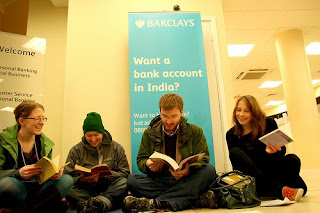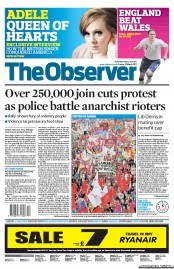 Since the events of last Saturday, both the mainstream media and the police have sought to blur the lines of distinction between UK Uncut and the black bloc 'anarchists' that attacked the Ritz, Santander and Starbucks. A total of 201 arrests were made following Saturday’s march. Charges have been brought against 149 people, 138 of which were charged with aggravated trespass in connection with the Fortnum & Mason protest organised by UK Uncut.
Since the events of last Saturday, both the mainstream media and the police have sought to blur the lines of distinction between UK Uncut and the black bloc 'anarchists' that attacked the Ritz, Santander and Starbucks. A total of 201 arrests were made following Saturday’s march. Charges have been brought against 149 people, 138 of which were charged with aggravated trespass in connection with the Fortnum & Mason protest organised by UK Uncut.New footage from the Guardian indicates that UK Uncut was deliberately targeted by police and this attempt to demonise UK Uncut and associate them with violent disturbances has been systematically reinforced by mainstream press and social networking sites. But why would the establishment seek to portray UK Uncut as violent ‘anarchists’? And why would the police choose to ignore violent behaviour in favour of arresting peaceful activists from a growing protest movement?
Well, on the face of it, UK Uncut is an easier and more manageable target – but that analysis is far too simple. We should instead ask who represents the greatest threat to the ‘establishment’?
In purely cosmetic terms, anarchists – with their penchant for smashing up expensive hotels and discharging paint bombs over high-end shops – are a fearsome threat to society. Their behaviour is sadistically iconic but, in truth, their actions alienate more than they attract and their activity is easily managed. But, my word, do they make for a good photo opportunity!
UK Uncut, on the other hand, represents a real and fundamental threat to the established order. The movement – fluid in its organisation and fiercely tech-savvy – has grown steadily since it was formed last year. Although not dogmatically political, their activity is distinctly class-based: they target organised capital or, more precisely, the tax-dodging classes – such as Vodafone, Top Shop or Boots – and their tactics are articulate, peaceful and original. Take, for example, the occupation of banks and the impromptu organisation of pop-up libraries or stand-up performance. Their thoughtful mobilisation – coupled with the resurrection of trade union activism – has had a profound effect on the established order and prompted this vicious backlash which hopes to gut the movement of activists and starve it of public support.
UK Uncut was targeted by police in an attempt to discredit them and encourage people to confuse peaceful demonstration against legitimate targets with violent vandalism. Anarchists were not targeted in the same way because their antics serve to fragment the labour movement by alienating potential support and providing a stick with which to beat the left. Characterising UK Uncut as thuggish criminals serves to undermine their sophisticated and peaceful activism.
The repression of UK Uncut has – at its very core – the class struggle and it shows that the antagonism between labour and capital is as strong as ever. UK Uncut has steadily been able to raise awareness of tax-dodging corporations and this has had a positive effect on raising the consciousness of British workers – but there was always going to be a backlash. On Monday it was announced that parliament is to investigate corporate tax avoidance – a formidable victory for the movement. Let’s hope it’s just the start.

















